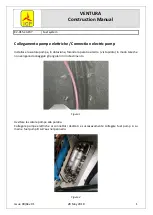
Revision: 2.3
Date: 10/30/20
F0-2
NOTE: FAA Regulations allow an additional qualified pilot during initial flight testing and
in such a circumstance it is permissible to deviate from 1050lb. See Advisory Circular 90-
116 for further information.
Data Retrieval from EFIS:
While the required flight test data gathering can be done by hand, it will be much simpler if the
data for each flight is retrieved from the EFIS by downloading onto a laptop computer and the
post flight data reduction done using Excel. An Excel "RV-12iS Flight Test Data” template can be
downloaded from the Downloads page of the Van’s Aircraft website which can be used to simplify
entering and archiving flight test data.
Post-Flight Activities:
Between each flight, identify and correct any discrepancies noted. If necessary, repeat flight test
card sections until the aircraft is adjusted correctly before continuing on to the next flight test card.
After each flight, download and review the data from the EFIS. Make any necessary adjustments
and calibrations to the aircraft and systems. Review the data and notes from the previous flight
and become familiar with the tasks to be performed on the next flight.
Directional (yaw) trim adjustment:
An off-center skid ball is common for many new airplanes. Small trim adjustments should be
made so that when at cruise speed the airplane flies straight and true without stick or rudder
input.
To test directional trim, establish and hold level flight. Remove your feet from the rudder pedals. If
the skid ball does not remain centered, rudder trim will be needed. Apply rudder as necessary to
center the ball and determine whether “right or left” trim will be needed.
Add bend angle to the trim tab for right rudder effect, straighten for left trim. Fly the airplane to
gauge the result. It may take several flights to determine the exact angle.
Lateral (roll) trim adjustment:
A roll tendency that increases with speed is common for many new airplanes. Small trim
adjustments should be made so that when at cruise speed the airplane flies straight and true
without stick or rudder input.
To test roll trim, establish and hold level flight and center the skid ball with the rudder (if the
aircraft is not in directional trim). Release the stick and note any roll tendency or “heavy wing”.
The structure of the RV-12iS flaperons allows roll trim to be varied through alteration of the
flaperon trailing edge bend radius. Experience has shown that roll trim can be achieved by
decreasing or “tightening” the trailing edge radius of the flaperon on the "light" wing - the one
coming up as the airplane rolls. Squeezing the trailing edge tighter (with just your fingers) along
the length of the flaperon will have an effect. Small variations in trailing edge shape can have
noticeable affects on control, and the skins will crack if squeezed too tight.
Fly the airplane to gauge the result. Several such trial-and-error attempts may be needed to
achieve the desired results. If an over-correction occurs, it can be corrected in two ways:
•
The opposite aileron’s trailing edge can be reduced slightly in the above manner,
providing that the aileron control forces have not increased too much. Stick force
increases as the trailing edge radius decreases.
•
A trailing edge radius which has been “tightened” too much can be expanded as shown in
the KAI, Section 5.7.
Summary of Contents for RV 12iS
Page 24: ...Revision 2 3 Date 10 30 20 G10 2 THIS PAGE INTENTIONALLY LEFT BLANK...
Page 36: ...Revision 2 3 Date 10 30 20 F1 6 THIS PAGE INTENTIONALLY LEFT BLANK...
Page 44: ...Revision 2 3 Date 10 30 20 F3 4 THIS PAGE INTENTIONALLY LEFT BLANK...
Page 48: ...Revision 2 3 Date 10 30 20 F4 4 THIS PAGE INTENTIONALLY LEFT BLANK...
Page 50: ...Revision 2 3 Date 10 30 20 G11 2 THIS PAGE INTENTIONALLY LEFT BLANK...
















































